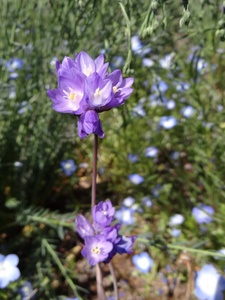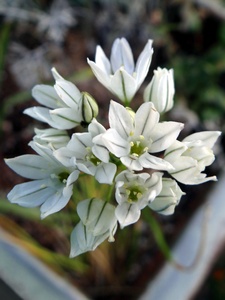 Harvest Cluster-Lily (Brodiaea elegans). Photo by queerbychoice.
Harvest Cluster-Lily (Brodiaea elegans). Photo by queerbychoice.
Cluster-Lilies are flowers in the triplet-lily family (Themidaceae). They are perennial herbs that form underground corms and go dormant during the dry season, disappearing underground.
Native Species
Eight species of cluster-lilies are native to Woodland, and three more are native to other parts of Yolo County.
Native to Woodland
 Blue Dips (Dipterostemon capitatus) mingle with Baby Blue Eyes (Nemophila menziesii) in a garden in Woodland. Photo by queerbychoice.
Blue Dips (Dipterostemon capitatus) mingle with Baby Blue Eyes (Nemophila menziesii) in a garden in Woodland. Photo by queerbychoice.
California Cluster-Lily (Brodiaea californica) is a one- to two-foot-tall purple cluster-lily that is native to all of Woodland and to the Yolo County foothills, but not to the Capay Hills or any low-elevation parts of Yolo County other than Woodland. It prefers full sun or partial shade and grows only in dry areas. It is ranked 1 out of 10 on the Ogren Plant Allergy Scale, indicating that it is a very safe choice for hay fever sufferers.
Early Harvest Cluster-Lily (Brodiaea coronaria) is a ten-inch-tall purple cluster-lily that is native to all of Woodland, Davis, Knights Landing, Monument Hills, and the northern half of West Sacramento, as well as to scattered areas in the Yolo County foothills (but not the Capay Hills). It follows the Highway 113 corridor but is absent from the I-505 corridor. It prefers full sun and is equally likely to grow in wet or dry areas. It is ranked 1 out of 10 on the Ogren Plant Allergy Scale, indicating that it is a very safe choice for hay fever sufferers.
Harvest Cluster-Lily (Brodiaea elegans) is a one- to 1.5-foot-tall purple cluster-lily that is native to all of Woodland and all of Yolo County except for a narrow rain shadow just east of the foothills and just east of the Capay Hills. It prefers full sun or partial shade and loamy or clay soil. It usually grows in dry areas. It is ranked 1 out of 10 on the Ogren Plant Allergy Scale, indicating that it is a very safe choice for hay fever sufferers.
Twining Snakelily (Dichelostemma volubile) is a two-foot-tall, usually pinkish cluster-lily that is native to the southwestern corner of Woodland and the portion of the valley that lies westward of Woodland, as well as to the Yolo County foothills, the Capay Hills, and the Dunnigan Hills. It prefers full sun or partial shade and grows only in dry areas. It is ranked 3 out of 10 on the Ogren Plant Allergy Scale, indicating that it is fairly unlikely to cause hay fever.
Blue Dips (Dipterostemon capitatus), also called Blue Dicks, are 1.5- to two-foot-tall purple cluster-lilies that are native to all of Woodland, Davis, Knights Landing, Monument Hills, and most of West Sacramento, as well as to scattered areas in the Yolo County foothills, including the Capay Hills. They follow the Highway 113 corridor but are absent from the I-505 corridor. They prefer full sun or partial shade and usually grow in dry areas. They are ranked 3 out of 10 on the Ogren Plant Allergy Scale, indicating that they are fairly unlikely to cause hay fever.
Common Muilla (Muilla maritima) is a one- to two-foot-tall white cluster-lily that is native to all of Woodland, Davis, most of West Sacramento, the area in between those three points, and the eastern slopes of the Dunnigan Hills. It prefers full sun or partial shade and grows only in dry areas.
 Wild Hyacinth (Triteleia hyacinthina) in a ceramic pot. Photo by queerbychoice.Wild Hyacinth (Triteleia hyacinthina) is a one- to two-foot-tall white cluster-lily that is native to all of Woodland and all of Yolo County except for a narrow rain shadow just east of the foothills and just east of the Capay Hills. It prefers full sun and is equally likely to grow in wet or dry areas. It is ranked 3 out of 10 on the Ogren Plant Allergy Scale, indicating that it is fairly unlikely to cause hay fever.
Wild Hyacinth (Triteleia hyacinthina) in a ceramic pot. Photo by queerbychoice.Wild Hyacinth (Triteleia hyacinthina) is a one- to two-foot-tall white cluster-lily that is native to all of Woodland and all of Yolo County except for a narrow rain shadow just east of the foothills and just east of the Capay Hills. It prefers full sun and is equally likely to grow in wet or dry areas. It is ranked 3 out of 10 on the Ogren Plant Allergy Scale, indicating that it is fairly unlikely to cause hay fever.
Ithuriel's Spear (Triteleia laxa), also called Wally Baskets, is a two-foot-tall purple cluster-lily that is native to all of Woodland, Davis, Knights Landing, Monument Hills, and most of West Sacramento, as well as to scattered areas in the Yolo County foothills, including the Capay Hills. It follows the Highway 113 corridor but are absent from the I-505 corridor. It is not picky about sun exposure but grows only in dry areas. It is ranked 3 out of 10 on the Ogren Plant Allergy Scale, indicating that it is fairly unlikely to cause hay fever.
Native to Yolo County
Dwarf Cluster-Lily (Brodiaea terrestris) is an eight-inch-tall cluster-lily that is native to all of Davis and much of West Sacramento, as well as the area in between. CalScape maps show its range tracing the outer perimeter of Spring Lake without technically extending into Woodland. It prefers full sun or partial shade and grows only in dry areas. It is ranked 1 out of 10 on the Ogren Plant Allergy Scale, indicating that it is a very safe choice for hay fever sufferers.
Forktooth Ookow (Dichelostemma congestum) is a four-inch-tall cluster-lily that is native to the Yolo County foothills, including the Capay Hills. It prefers full sun or partial shade and grows only in dry areas. It is ranked 3 out of 10 on the Ogren Plant Allergy Scale, indicating that it is fairly unlikely to cause hay fever.
Coast Range Triplet-Lily (Triteleia lugens), also called Dark-Mouthed Triplet-Lily, is a one-foot-tall yellow cluster-lily that is native to the Yolo County foothills, including the Capay Hills. It grows only in dry areas. It is ranked 3 out of 10 on the Ogren Plant Allergy Scale, indicating that it is fairly unlikely to cause hay fever.
Links
CalScape: Brodiaea californica
Wikipedia: Brodiaea californica
CalScape: Dichelostemma volubile
Wikipedia: Dichelostemma volubile
CalScape: Dipterostemon capitatus
Wikipedia: Dipterostemon capitatus
CalScape: Triteleia hyacinthina
Wikipedia: Triteleia hyacinthina
Wikipedia: Brodiaea terrestris
CalScape: Dichelostemma congestum


